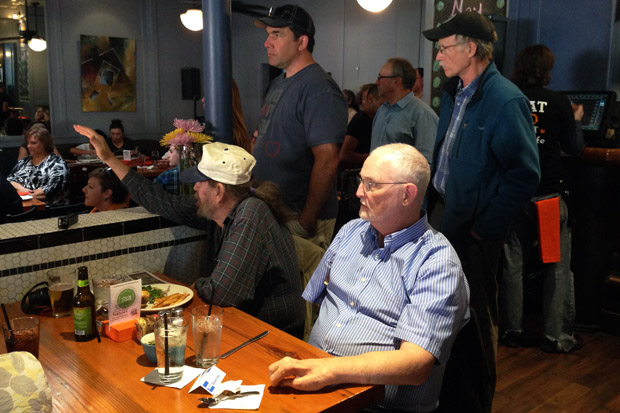Public Forum Questions Reveal Concern About Climate Change in Oklahoma
-
Joe Wertz

Joe Wertz / StateImpact Oklahoma
People waiting to ask questions at StateImpact's public forum on how climate change is affecting Oklahoma.
Last week, we hosted a public forum on how climate change affects Oklahoma. A panel of experts took audience questions on water and agriculture, and if the discussion is any guide, Oklahomans are curious, frustrated and concerned about climate change.
The Picasso Café in Oklahoma City was standing room only. One by one, audience members took the microphone and posed questions to our panelists: Clay Pope, Executive Director of the Oklahoma Association of Conservation Districts, and Dr. David Engle, Director of Oklahoma State University’s Water Resources Center.
One attendee, Glen from Norman, talked briefly about the water problems his hometown has been facing. But after talking to an official from Altus, one of the most drought-stricken cities in the state, Glen was worried about the broader impacts of long-term drought and a hopeful mindset among many Oklahomans: We’re just waiting for things to return to “normal.”
“Is it a fact that one of the greatest problems you have is battling the myth that droughts are just rude interruptions from good times?,” Glen asked.
Engle said “normal” is hugely varied in Oklahoma and other Great Plains states.
“Our normal, our climate is marked by dry and wet periods,” he says. “In fact, extended wet periods followed by extended dry periods.”
Pope said the big droughts that have defined Oklahoma — those in the 1930s and ‘50s — better represent the state’s geologic history. The good times, those periods between the droughts, that’s the anomaly.
“From the time we had the Land Run until today, it’s been mighty wet in Oklahoma,” Pope told Glen from Norman.
In Oklahoma, climate change and water policy are inseparable. And water worries dominated the discussion at the event: From soil erosion and no-till farming, to aquifer depletion and the water oil and gas companies use for drilling.
Josh, an oilfield worker from Yukon, said he’d seen many farmers’ ponds dry up after selling water to drillers in northwestern Oklahoma
“I understand people are talking about the fracking process, but nobody is talking about the use of water,” Josh said.
Most of the drought talk centered on western and northwestern regions of the state, but Russell Doughty with the advocacy group Oklahomans for Responsible Water Policy said eastern regions are vulnerable, too.
“What are we doing here in the state with our forests, and how are we looking at forests and what role they might play in making Oklahoma more resilient to climate change?,” Doughty asked.
Pope acknowledged the role forests play and said they’ve suffered from a changing climate, too. ”We’ve knocked the water cycle out of whack, we’ve knocked the carbon and nitrogen cycle out of whack.”
Oklahoma has a variable climate and geography, and both Pope and Engle said the state’s forests, grasslands and watersheds all sustain each other. Disrupting the fragile ecology of one region of the state will lead to problems elsewhere, downriver, downwind, or at the local grocery store.
Maintaining a sustainable balance has never been easy, but one audience member said it’s what we know about the future that’s really frightening.
“We know we’re getting hotter and we know we’re going to get drier. We might have to be more worried about adapting, rather than preventing, climate change,” he said.
In his mind, it doesn’t really matter if everyone agrees on the cause of climate change. Oklahomans just need to look at other states and the history here to know things could get a lot worse and come up with a plan to respond.
